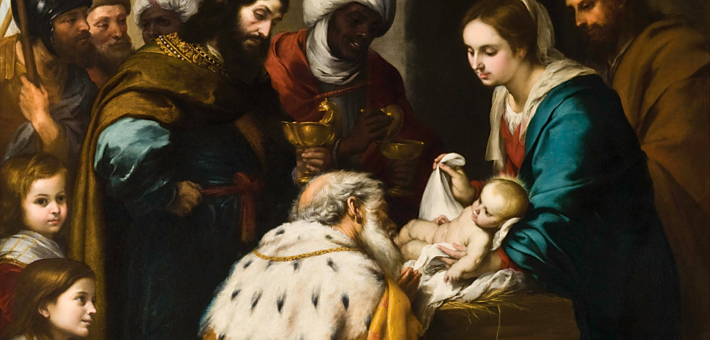Commentary on Isaiah 60:1-6
Isaiah 60:1–6 resonates strongly with Epiphany’s theme of the manifestation of Jesus as the light to the Gentiles and is thus paired this week with Matthew’s account of the visitation of the magi. Even though Matthew 2 explicitly cites Micah 5, a different prophetic text, some scholars suggest that the Matthean account was actually composed with Isaiah 60 in mind: “Nations shall come to your light, and kings to the brightness of your dawn” (Isaiah 60:3); “they shall bring gold and frankincense, and shall proclaim the praise of the LORD” (Isaiah 60:6).
In its literary placement, this passage appears in Third Isaiah (Isaiah 55–66), a section of the book with a dominant pessimistic and frustrated tone. Elsewhere in Third Isaiah, the anonymous voice complains of God’s silence (Isaiah 63:15; 64:12), pleading for divine intervention against rampant injustice (Isaiah 57:1–2; 64:1–4) and unfaithfulness (Isaiah 57:3–10; 65:3–4). It laments, “Justice is far from us and righteousness beyond our reach” (Isaiah 59:9). Its words depict a suffering and divided community, likely that of Judeans living in the Persian province of Yehud after their repatriation from Babylon in the fifth century BCE. This same “postexilic” context is reflected in the books of Ezra, Nehemiah, Haggai, Zechariah, and Malachi.
The small cluster of chapters found in Isaiah 60–62, however, more clearly echoes the hopeful tone of chapters 40–54, a collection commonly called Second Isaiah, which was likely written earlier, during the forced displacement of Judeans to Babylon (“the exile”). Both Isaiah 60–62 and Second Isaiah espouse elaborate promises of the restoration of Jerusalem: The city is offered comfort (Isaiah 61:2–3; see also Isaiah 40:1), those willing to return to Jerusalem are promised divine protection (Isaiah 60:19–20; 61:3–4; see also Isaiah 41:17–20; 43:14–17), and Jerusalem is characterized as a bereft mother awaiting her children’s return (Isaiah 60:4–5; see also Isaiah 49:14–23; 52:1–2; 54:1–8).
Indeed, Isaiah 60 envisions sons and daughters streaming into the city along with the riches of the nations. The one who was once forsaken and hated (60:15) will now be served and honored by its former oppressors (60:10–11). The city will take on a new status: holy, redeemed, sought out, no longer forsaken (62:12).
Why has the hopeful oasis of Isaiah 60–62 been placed here, in the midst of Third Isaiah’s despair? In the historical context of the postexilic period, this reminder of the hopes of the past may have served to temper the harsh realities of the present. Those living in the Persian province of Yehud may have longed for Jerusalem to be larger, more prestigious, and more honored than its status as the small outpost of a larger empire reflects. Similar hopes for the expansion and glorification of Jerusalem are found in Isaiah 2:1–5 (paralleled in Micah 4:1–7), also likely composed in the Persian period.
In the present, however, it is easy to romanticize the promises of the past, to repeat the hopes of our ancestors without recognizing the shortcomings of their aspirations. Indeed, for all of its hopefulness this passage does not advance an image of equality. The nations transfer their wealth to the restored Jerusalem; the nations who do not serve will perish (Isaiah 60:12).
In Isaiah 61:5, strangers and foreigners become laborers who serve, and the wealth of the nations comes to those who receive good news and comfort (61:6).
It is also easy to reclaim beloved imagery from the past without paying careful attention to its potential harm. The metaphor of a mother welcoming her children home can communicate comfort, but it also can reinforce gendered stereotypes that recognize women as important only for their roles as mothers. The metaphor also can be interpreted in ways that perpetuate the hurtful trope that the loss of one child can be healed by the birth of another.
When we read Isaiah 60 in the larger literary context of Third Isaiah, however, we see ways in which this community was not limited by the aspirations of the past. In the midst of its frustrations, Third Isaiah envisions a new kind of community. Isaiah 56:3–8 welcomes foreigners and sexual minorities (here typified by eunuchs) into the community, and Isaiah 66:18–24 explicitly includes “sons of foreigners.” All who commit to maintaining justice and to the community’s core identity, here indicated by the observance of the sabbath (Isaiah 56:2–8), are embraced, including those who historically have been marginalized.
Seemingly, the community of Third Isaiah was inspired by the words of the ancestors but also was willing to reframe hope for its own context. How can preachers help hearers do the same? How can the past inspire us but not limit our welcome? In our worship as we read familiar texts, repeat familiar liturgical metaphors, and find comfort in familiar hymns, how can we also train our ears to hear whom our words exclude and how we might allow new light to shine?
For Further Reading
Julia M. O’Brien, Prophets Beyond Activism: Rethinking the Prophetic Roots of Social Justice (Louisville: Westminster John Knox, 2024).


January 6, 2025